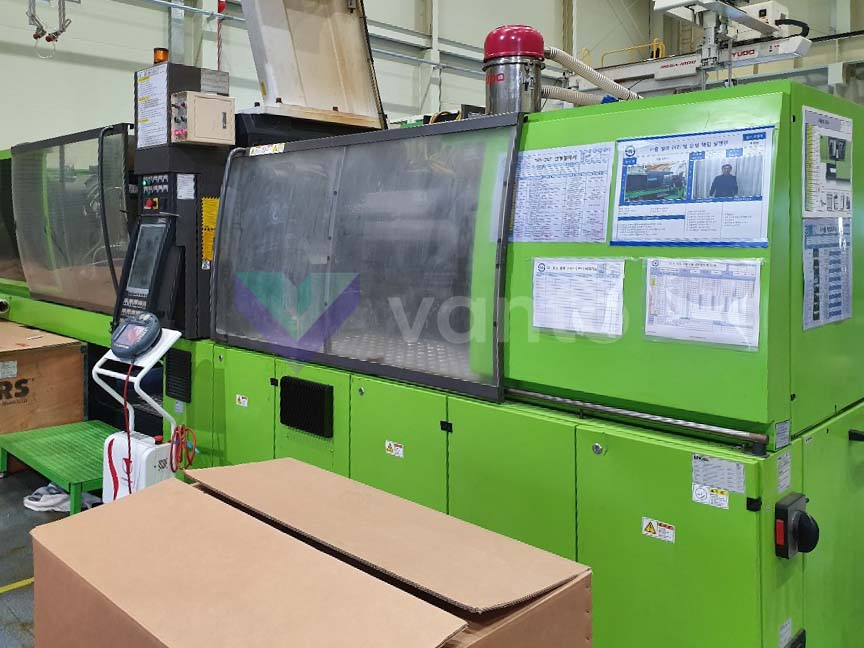An injection molding machine, also known as an injection press, is a machine for manufacturing plastic products through the injection molding process. It consists of two main parts, an injection unit and a clamping unit.
Injection molding is a manufacturing process to produce large volume parts. Normally it is used in mass production processes, where the same part is created thousands or even millions of times in a row.
The molds of the injection molding machine can be held horizontally or vertically. Most machines are oriented horizontally, but vertical machines are used in some niche applications such as insert molding, which allows the machine to take advantage of gravity. Some vertical machines also do not require the mold to be attached. There are many ways to attach the tools to the plates, the most common being the manual clamps (both halves are screwed to the plates); however, hydraulic clamps (chocks are used to hold the tool in place) and magnetic clamps are also used. Magnetic and hydraulic clamps are used when rapid tool changes are required.
The person who designs the mold chooses whether the mold uses a cold channel system or a hot channel system to carry the plastic and fillings from the injection unit to the cavities. A cold runner is a simple channel carved into the mold. The plastic that fills the cold channel cools as the piece cools and is then ejected with the piece as a drinking fountain. A hot runner system is more complicated, often using cartridge heaters to keep the plastic in the guides warm while the piece cools. Once the piece is ejected, the plastic left in a hot runner is injected into the next piece.
Types of injection molding machines
The machines are mainly classified by the type of driving systems they use: hydraulic, mechanical, electrical or hybrid
Hydraulic injection molding machines
Historically, hydraulic presses have been the only option available to molders until Nissei Plastic Industrial Co., LTD introduced the first fully electric injection molding machine in 1983. Hydraulic machines, although not as precise, are the predominant type in Most of the world. With the exception of Japan.
Mechanical injection molding machines
Mechanical type machines use the lever system to accumulate tonnage on the side of the machine clamp. Tonnage is required on all machines so that the clamp side of the machine does not open (that is, half of the tool is mounted on the stage) due to the injection pressure. If half of the tool opens, it will create a flash in the plastic product.
Electric injection molding machines
The electric press, also known as Electric Machine Technology (EMT), reduces operating costs by reducing energy consumption and also addresses some of the environmental concerns surrounding the hydraulic press. Electric presses have proven to be quieter, faster and more accurately, however, the machines are more expensive.
Hybrid injection molding machines (sometimes referred to as “servohydraulics”) are intended to take advantage of the best features of hydraulic and electrical systems, but today they use almost the same amount of electricity to operate as an electric injection molding machine depending on the maker.
A robotic arm is often used to remove molded components; either by side or upper entry, but it is more common for parts to fall out of the mold, through a ramp and into a container.
Components of the injection molding machine
Injection unit
It consists of three main components
- Screw motor drive
- Reciprocating screw and barrel
- Heaters, thermocouple, ring plunger
Clamping unit
It consists of three main components
- Mold
- Clamping motor clamping
- Bonding bars, the sender is attached to the edge of a worktable
What is the disadvantage of injection molding?
Initial costs tend to be very high due to design, testing and tooling requirements. If you are going to produce parts in large volumes, make sure you get the right design at the first. That is more complicated than you think. Getting the right design includes designing and then making a prototype of the piece itself to the specification.
The initial development of the prototype is usually completed in a 3D printer and often in a different material (such as ABS plastic) from which the final part will be constructed.
The design of an injection molding tool for an initial production round is usually created from 300-1000 injection molded prototypes in the production material requires the development of an injection molding tool. Refining each and every detail in the injection molding tool before mass production in an injection mold manufacturing plant.
It is important to have high quality machinery to optimize processes, on our website you will find injection molding machines of the best brands such as ENGEL, KRAUSS MAFFEI, HUSKY, NETSTAL, NEGRI BOSSI.

